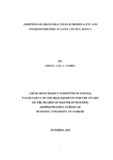| dc.description.abstract | The research study was to determine the adoption of green practices in the Hospitality
and Tourism Industry in Lamu County, Kenya. The research looked at various factors
cited as green practices adoption this include green energy consumption, water and
liquid waste, air quality and green house gas emissions, green building and design and
solid waste management. The study was guided by the following research objectives:
to determine the extent of adoption of green practices in the Hospitality and Tourism
Industry in Lamu County, Kenya and to establish the factors influencing adoption of
green practices by hospitality and tourism industry in Lamu County, Kenya. The
research used cross-sectional census survey design to collect quantitative by use of
primary data questionnaires. This was preferred as it could enable the researcher to
obtain complete and possible accurate information. The population was 31 hotels and
the response number was 24 of the hotels. The data collected was then analyzed by use
of SPSS. The presentation of data was by tables with frequencies and percentages to
show the statement rate under study. The findings indicated that many Lamu County
hotels are frequented by visitors from Europe with many of them being adults of over
20 years. The research also showed over 75% of hotels in Lamu have bed occupancy
of less than 30 beds making them small hotels and many hotels are over 15 years old.
Of the green practices adopted. Eco-friendly building and designs led in adopting
green practices followed by solid waste management, then water and liquid waste
management, then green consumption and efficiency air finally clean air quality
management and water control as the least variable adopting green practice. The report
is organized into five chapters. Chapter one presents the introduction of the study,
chapter two reviews the literature for similar study, chapter three describes how the
study was conducted, chapter four shows the research study findings and chapter five
gives the discussions and conclusions for the study. The overall study
recommendations should be that the tourism and hospitality industry should act fast
and implement green practices since there are potential benefits to the county. The
overall research study revealed that hotels in Lamu have started to appreciate the ecofriendly
practices in running and managing their hotels and that there is still room for
improvement in adopting green practices. The research has also shown that the main
drivers for hotels to adopt green practices is hotel policy and the customer‟s
attractions to green practices and the accrued benefits the hotels get in saving. | en_US |



